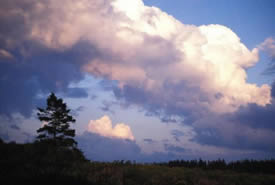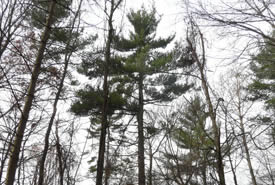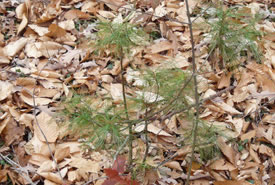Eastern White Pine

White Pine (Photo by Douglas C. Leitch, Dovekie Images)
History of the eastern white pine in Europe and North America
In previous centuries, the British and French navies prized the light, soft, creamy white wood of the eastern white pine, using it for masts and spars for their ships. Agents of the British Crown marked these trees and reserved them for the Royal Navy.
European settlers used white pine for boards to build their barns, many of which still stand today.
This picturesque tree is also a favourite subject of many Canadian artists, and features prominently in many paintings by the Group of Seven.
Port Rowan, Backus Woods and the eastern white pine
Trees marked for the Royal Navy were known as "spar trees." A spar tree marked for Queen Victoria's use stood in Backus Woods until the 1950s, when it was cut down.
In fact, Port Rowan, a community southwest of Backus Woods, was once a busy port from which lumber from the surrounding area was exported. In 1849, shipments leaving Port Rowan included 6,570,000 board feet of pine lumber (a board foot is the volume of a one-foot length of a board one foot wide and one inch thick and is a standard cubic measurement used to describe volume of commercial timber).

Did you know?
The stately eastern white pine was declared the official arboreal emblem of Ontario in 1984. The species figures prominently in the logging history of the province, with no other tree having had such an impact on Ontario's history. It is the tree the province was built on.
Although no longer Ontario's foremost forest product, the eastern white pine is still an important part of the lumber industry in the province and an important part of Ontario's history.

White Pine (Photo by Bernt Solymar)

White pine seedlings (Photo by Bernt Solymar)
Supported by the Weston Family Foundation.




